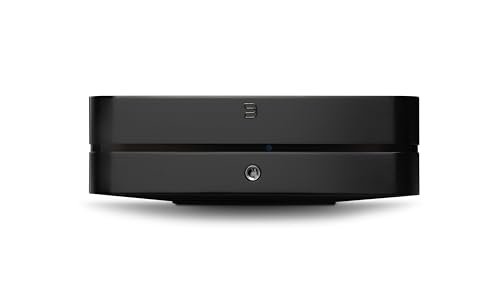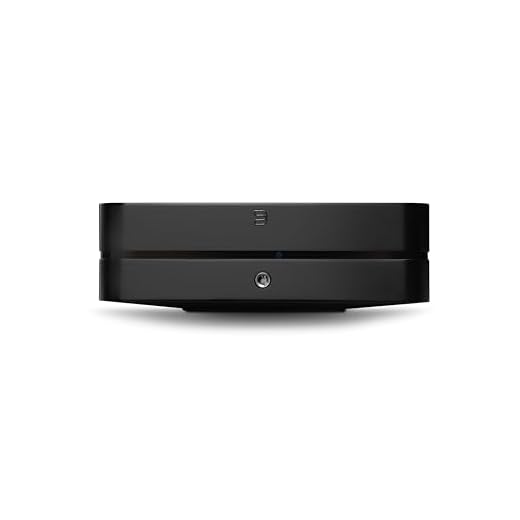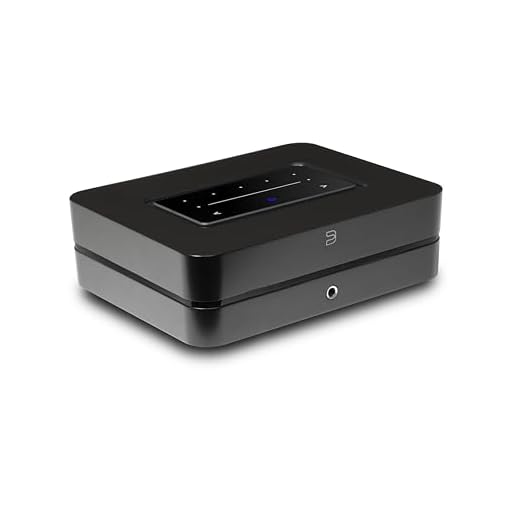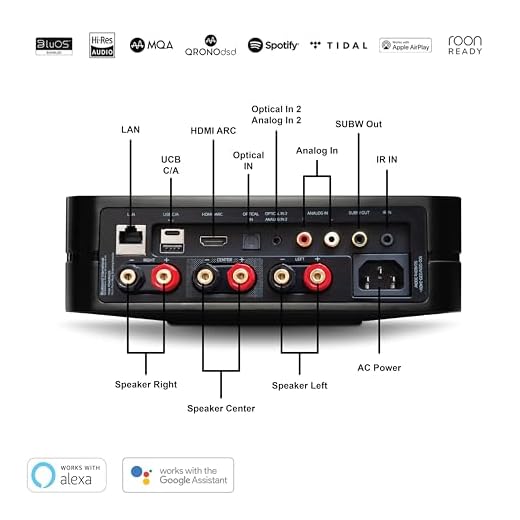Bluesound Powernode 2025 Wireless Music Amplifier
Introduction
The Bluesound Powernode (2025) is a compact, high-resolution streaming amplifier designed to bring audiophile-grade sound and modern streaming convenience to living rooms, media rooms, and multi-room installations. Manufactured by Bluesound (Lenbrook Industries), the Powernode sits in the streaming amp / compact integrated amplifier category and is intended for users who want to replace a bulky AV receiver with a simpler, networked device that handles music, TV audio, and multi-room playback while delivering powerful, low‑distortion amplification.
Product Overview
Model: Bluesound Powernode (2025) Wireless Multi-Room High Resolution Music Streaming Amplifier. Retail price at the time of this review: $1,199. It delivers 100W per channel in stereo and can be configured as an 80W x 3 LCR amplifier for use as a compact home theater front-end. The unit is built around Bluesound’s DirectDigital amplification and integrates the BluOS multi-room streaming platform to access streaming services, internet radio, and local libraries.
Appearance and Build
The Powernode adopts a minimalist, contemporary aesthetic. The chassis is finished in matte black and has a compact footprint intended to fit on a shelf or media credenza without dominating the space. The most distinctive design element is a touch-sensitive glass panel on the top/front surface that contains five customizable preset shortcuts — this blends tactile simplicity with a modern look. Overall, the unit is understated and cleanly styled so it pairs well with modern AV furniture and flat-screen TVs.
Materials are typical for this category: a solid-feeling metal or reinforced composite chassis with a glass touch surface. The finish and controls prioritize subtlety over flashy design; if you want a bold centerpiece the Powernode is not that product, but for integrated systems and discreet installs it fits well.
Key Features & Specifications
- Amplification: DirectDigital amplification — 100W per channel in stereo (8 ohms), 80W per channel in 3-channel LCR mode (8 ohms) with center channel support.
- High-resolution audio: Supports MQA, FLAC, DSD256, WAV and other hi-res formats.
- Streaming / Platform: BluOS multi-room streaming platform — access to 20+ streaming services, internet radio, and local libraries; supports up to 64 zones.
- Connectivity: HDMI eARC for TV audio integration, USB-C input, dedicated subwoofer output, analogue and digital inputs (typical for the category), and wireless surround pairing for adding rear speakers.
- Personal listening: 6.3 mm (1/4″) headphone output with THX AAA technology for ultra-low distortion and detailed headphone listening.
- Wireless: Apple AirPlay 2, aptX HD Bluetooth, TIDAL Connect, Spotify Connect.
- Smart home and control: Integrates with Control4, Crestron, RTI and other control systems; five touch presets on the glass panel.
- Form factor: Minimalist footprint, matte black finish, touch-sensitive control panel.
- Model/Part: N331BLKUNV. Warranty: 1 year. Color: Black. Price: $1,199.
Using the Powernode — Real-World Experience
Music Listening (Critical & Casual)
In two-channel stereo the Powernode delivers a surprising amount of drive for its size. DirectDigital amplification produces clean, low-distortion output with good transient control and a neutral-to-warm tonal balance that suits a wide range of music. High-resolution files (FLAC, MQA, DSD256) sound detailed and spacious when streamed via BluOS or played from a USB source. Audiophile listeners will appreciate the lack of noticeable noise and the faithful tonality; the unit reveals texture in well-recorded tracks without sounding harsh.
TV and Movies (HT / LCR Mode)
The inclusion of HDMI eARC makes TV integration straightforward — connect your TV to the Powernode and the TV’s audio will pass to your speakers with minimal fuss. The 3-channel LCR mode (80W x 3) is particularly useful if you want a compact front-stage setup for dialogue clarity without a full AV receiver. While it won’t replace a flagship surround receiver for large home theaters with Dolby Atmos overhead arrays, it provides a compact, clearer-than-TV-speaker upgrade for most living rooms.
Multi‑Room & Networked Use
BluOS is the backbone of the multi-room experience. Setting up zones and grouping players is intuitive via the BluOS Controller app on phone/tablet. The platform handles gapless playback, offers a wide range of streaming services (Spotify, Tidal, etc.), and syncs reliably with other BluOS devices. For homeowners planning whole-home audio, the Powernode works well as a hub or zone endpoint and supports up to 64 zones in larger systems.
Headphones & Personal Listening
The 6.3mm headphone output with THX AAA tech is a notable plus. Headphone sound is exceptionally clean with very low distortion and good dynamics. This makes the Powernode an attractive choice for those who want a single device that handles both loudspeaker and critical headphone listening.
Setup and Usability
Physical setup is straightforward: connect speakers, TV via eARC, optional subwoofer, and configure the network via the app. The five touch presets on the glass panel are genuinely useful for quick access to favorite stations, playlists, or inputs. The BluOS app is feature-rich, but new users may find the depth of options slightly daunting initially; however, the basics are easy to navigate.
Pros
- Excellent sound quality for a compact streaming amplifier — clean, detailed, and low distortion.
- High-resolution format support including MQA and DSD256.
- Flexible: stereo and 3-channel LCR modes, HDMI eARC, subwoofer output, USB-C.
- BluOS offers robust multi-room streaming and wide service support, with reliable syncing across zones.
- THX AAA headphone amplification provides outstanding personal listening performance.
- Minimalist design with touch-sensitive presets makes daily use simple and attractive.
Cons
- Price is relatively high compared with simpler streaming amps — $1,199 may be a stretch for budget-conscious shoppers.
- Warranty coverage is limited to one year — competitors sometimes offer longer coverage.
- Not a full-featured AV receiver — lacks multiple HDMI inputs and advanced surround processing (no Dolby Atmos decoding for speaker arrays beyond basic LCR setups).
- For very large rooms or highly inefficient speakers, 100W/ch may not be sufficient for maximum SPL or headroom required by some listeners.
- BluOS familiarity required to access the full feature set — there is a learning curve for non-technical users.
Who Should Buy It?
The Powernode is ideal for listeners who want high-quality two-channel sound and multi-room streaming in a compact package, for families upgrading TV audio without a big AV receiver, and for users who want an integrated headphone solution with THX AAA performance. It’s especially attractive for those already invested in or willing to adopt the BluOS ecosystem.
Conclusion
The Bluesound Powernode (2025) is a thoughtfully designed streaming amplifier that balances high-resolution audio performance with modern connectivity and multi-room convenience. It produces clean, detailed sound and offers flexible operation as a stereo amp, a 3-channel front stage for TV, and a capable multi-room endpoint via BluOS. The THX AAA headphone output, HDMI eARC, and touch presets are practical advantages for everyday use.
The main trade-offs are price and scope: at $1,199 it sits above entry-level options, and it is not a full AV receiver replacement for large, dedicated home theaters that need many HDMI inputs or advanced immersive-sound processing. For most buyers looking for a refined, space-efficient, and networked listening solution that prioritizes sound quality and streaming, the Powernode is a compelling, well-executed choice.





